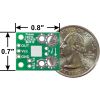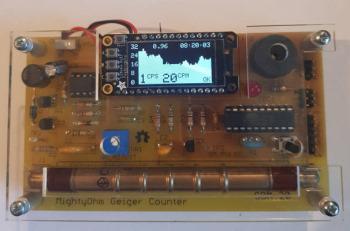ACHS-7125 Current Sensor Carrier -50A to +50A
In stock, ships same business day if ordered before 2PM
Fastest delivery: Tomorrow*
Disclaimer:
For next-day delivery, the shipping address must
be in the AusPost next-day network, eParcel Express must be selected, and the order must be placed
before 2PM AEST Mon-Thurs excluding NSW Public Holidays. Orders may be delayed due to AusPost
pickup timings and order verifications. eParcel Express is typically a 1-day service within the
AusPost next-day network, though it is sometimes 2+ days.
Quantity Discounts:
- 10+ $10.60 (exc GST)
- 25+ $10.27 (exc GST)
 |
This current sensor is a carrier board or breakout board for Broadcom’s ACHS-7121/7122/7123/7124/7125 Hall effect-based linear current sensors; Pololu therefore recommend careful reading of the ACHS-7121/7122/7123 datasheet (1MB pdf) or ACHS-7124/7125 datasheet (1MB pdf) before using this product. The following list details some of the sensor’s key features:
- The conductive path internal resistance is typically 0.7 mO, and the PCB is made with 2-oz copper, so very little power is lost in the board.
- Use of a Hall effect sensor means the IC is able to electrically isolate the current path from the sensor’s electronics (up to 3 kV RMS), which allows the sensor to be inserted anywhere along the current path and to be used in applications that require electrical isolation.
- 80 kHz bandwidth that can optionally be decreased by adding a capacitor across the board pins marked “filter”.
- High accuracy and reliability: typical total output error of ±1.5% at room temperature with factory calibration, an extremely stable output offset voltage, and almost zero magnetic hysteresis.
- Robust sensor IC can tolerate 100 ms transient current spikes up to 100 A.
- Wide operating temperature range of -40°C to 110°C.
The pads are labeled on the bottom silkscreen, as shown in the picture to the right. The silkscreen also shows the direction that is interpreted as positive current flow via the +i arrow.
Pololu sell five different versions of this board (±10A, ±20A, ±30A, ±40A, and ±50A) so you should consider adding your own distinguishing marks or labels if you will be working simultaneously with multiple versions. A white box is provided on the bottom silkscreen of the board to make labeling easier. You can also distinguish the versions by reading the text on the IC.
Details for item #4034
|
|
The ACHS-7124 sensor operates at 5 V and is designed for bidirectional input current from -50 A to 50 A. When Vcc is 5 V, the output voltage is centered at 2.5 V and changes by 40 mV per amp of input current, with positive current increasing the output voltage and negative current decreasing the output voltage.
This board ships assembled with all surface mount components, and a 3×1 strip of 0.1" header pins is included but not soldered in.
Note: This sensor should not be operated at sustained currents over 40 A without additional external cooling. In Pololu's tests, Pololu found that with sufficient current path connections, the IC could tolerate 50 A for approximately two minutes before exceeding its maximum temperature rating of 150°C, and it could tolerate up to 40 A continuously. Therefore, unless you are taking special steps to keep the IC cool, Pololu recommend limiting continuous currents to under 40 A. Even with a low conductive path resistance of 0.7 mO, the board can get hot enough to burn you when the current is in the tens of amps, and the IC does not feature any kind of over-temperature protection, so thermal issues should be taken into consideration for high currents.
Using the sensor
 |
This sensor has five required connections: the input current (IP+ and IP-), logic power (VCC and GND), and the sensor output (OUT).
The sensor requires a supply voltage of 4.5 V to 5.5 V to be connected across the VCC and GND pads, which are labeled on the bottom silkscreen, and the sensor outputs an analog voltage that is linearly proportional to the input current.
The FILTER pin lets you adjust the board’s bandwidth by adding a capacitor, CF, to ground (a ground pad has been added next to the FILTER pin for convenience) in parallel with the 1 nF capacitor that is already on the board. Without any external filter capacitor, the bandwidth is 80 kHz. The datasheet provides more information on how the external filter capacitor affects bandwidth.
You can insert the board into your current path in a variety of ways. For low-current applications, you can solder 0.1" male header pins to the board via the smallest pair of through-holes on the input-current side of the board. For higher-current applications, you can solder wires directly to the through-holes that best match your wires, or you can use solderless ring terminal connectors. The largest pair of through-holes are big enough for #6 screws.
|
|
Warning: This product is intended for use below 30 V. Working with higher voltages can be extremely dangerous and should only be attempted by qualified individuals with appropriate equipment and protective gear.
Schematic and dimension diagrams
 |
Schematic diagram of the ACHS-712x Current Sensor Carrier. |
|---|
The dimension diagram is available as a downloadable PDF (318k pdf).
People often buy this product together with:
 | ACHS-7121 Current Sensor Carrier -10A to +10A |
 | ACHS-7122 Current Sensor Carrier -20A to +20A |
 | ACHS-7123 Current Sensor Carrier -30A to +30A |
Dimensions
| Size: | 0.7" x 0.8" |
|---|---|
| Weight: | 1.5 g |
General specifications
| Current sense: | 0.040 V/A1 |
|---|---|
| Minimum logic voltage: | 4.5 V |
| Maximum logic voltage: | 5.5 V |
| Supply current: | 15 mA |
| Version: | -50A to +50A |
Identifying markings
| PCB dev codes: | cs01b |
|---|---|
| Other PCB markings: | 0J12458, blank white box |
Notes:
- 1
- When Vcc is 5 V.
File downloads
Broadcom ACHS-7121, 7122, and 7123 current sensor datasheet (1MB pdf)
Broadcom ACHS-7124 and 7125 current sensor datasheet (1MB pdf)
Dimension diagram of the ACHS-712x Current Sensor Carriers (318k pdf)
3D model of the ACHS-712x Current Sensor Carriers (3MB step)
Drill guide for ACHS-712x Current Sensor Carriers (42k dxf)
This DXF drawing shows the locations of all of the board’s holes. The through-hole sizes and locations in this file also apply to cs01b versions of the PCB, though some of the via locations are different.
Exact shipping can be calculated on the view cart page (no login required).
Products that weigh more than 0.5 KG may cost more than what's shown (for example, test equipment, machines, >500mL liquids, etc).
We deliver Australia-wide with these options (depends on the final destination - you can get a quote on the view cart page):
- $3+ for Stamped Mail (typically 10+ business days, not tracked, only available on selected small items)
- $7+ for Standard Post (typically 6+ business days, tracked)
- $11+ for Express Post (typically 2+ business days, tracked)
- Pickup - Free! Only available to customers who live in the Newcastle region (must order online and only pickup after we email to notify you the order is ready). Orders placed after 2PM may not be ready until the following business day.
Non-metro addresses in WA, NT, SA & TAS can take 2+ days in addition to the above information.
Some batteries (such as LiPo) can't be shipped by Air. During checkout, Express Post and International Methods will not be an option if you have that type of battery in your shopping cart.
International Orders - the following rates are for New Zealand and will vary for other countries:
- $12+ for Pack and Track (3+ days, tracked)
- $16+ for Express International (2-5 days, tracked)
If you order lots of gear, the postage amount will increase based on the weight of your order.
Our physical address (here's a PDF which includes other key business details):
40 Aruma Place
Cardiff
NSW, 2285
Australia
Take a look at our customer service page if you have other questions such as "do we do purchase orders" (yes!) or "are prices GST inclusive" (yes they are!). We're here to help - get in touch with us to talk shop.
Have a product question? We're here to help!
Videos
View AllGuides
The Maker Revolution
Getting Hands-on with Sensors
Projects
WhyzaGC - Feather ESP32 addon to the MightyOhm Gieger Counter
Makers love reviews as much as you do, please follow this link to review the products you have purchased.




















Product Comments